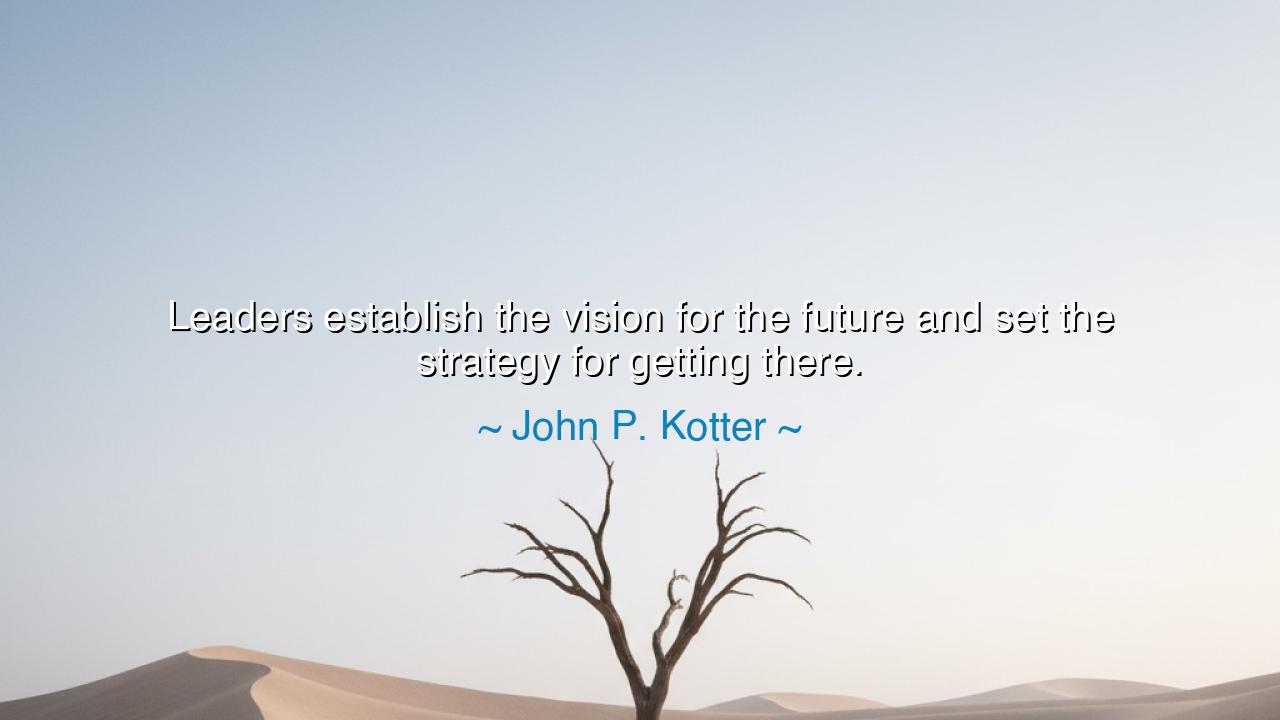
Leaders establish the vision for the future and set the strategy






“Leaders establish the vision for the future and set the strategy for getting there.” Thus spoke John P. Kotter, a sage of leadership and change, whose teachings have guided the hearts and minds of those who seek to steer the destiny of organizations and nations alike. In these words lies a timeless truth: that the true leader is not merely a commander of tasks, nor a keeper of order, but a visionary—one who sees beyond the horizon, who gazes into the mist of the unknown and discerns a path where others see none. Leadership, in its purest form, is not about control, but about creation—the shaping of a future that does not yet exist.
Kotter, whose wisdom arises from decades of study in the halls of Harvard, wrote these words as part of his great work on change management—on how human systems, whether in business or in life, transform and evolve. His words come from the understanding that people do not move forward by accident; they move because someone shows them why and where to go. The vision is the fire that burns ahead, the distant light that gives meaning to the journey. Without it, effort dissolves into confusion. Without it, strength is scattered like dust upon the wind. The strategy, then, is the map that connects present to future, the bridge between dream and reality. The leader’s task is to weave both—the fire and the bridge—into one living purpose.
To establish vision is no small feat. It requires imagination, courage, and faith. It is to stand before chaos and declare order—to look upon what is and see what could be. The visionary must be willing to endure misunderstanding, for those who see beyond the present often walk alone. Yet history remembers them. When Martin Luther King Jr. spoke of a dream—a nation rising from the valleys of division into the light of brotherhood—he was establishing not just hope, but vision. His words were not a plan of steps, but a direction of spirit. Others, inspired by that vision, built the strategy—marches, laws, and reforms that brought the dream closer to earth. Thus, vision and strategy are two wings of the same bird; without both, flight is impossible.
And so it was, too, with Winston Churchill during the dark years of the Second World War. When Britain stood alone against tyranny, surrounded by fear and ruin, he did not rally his people with numbers or tactics. He gave them a vision: victory, endurance, and survival of freedom itself. His words—“We shall never surrender”—became a torch that lit the hearts of millions. Yet beneath that fiery rhetoric lay strategy—alliances, production, communication, and the wise use of limited strength. In his union of vision and method, he exemplified Kotter’s wisdom: the leader both imagines the summit and charts the path that climbs toward it.
Many mistake leadership for authority, but Kotter reminds us that true leadership is an act of service. The leader is the one who sees the storm coming and sets the sails. They stand at the helm, not for power, but for direction. The vision belongs not to them alone but to all who follow; their duty is to give it form and focus. The strategy is not a rigid plan, but a living guide—able to adapt, to learn, to grow as the world shifts around it. The wise leader listens as much as they command; they adjust their course not from fear, but from wisdom.
From Kotter’s teaching, we may draw this lesson: that every human being is called, in some measure, to leadership. Whether one guides a nation, a company, a family, or simply oneself, the same principle holds. See clearly. Plan wisely. Move purposefully. Establish a vision worthy of your soul, something larger than comfort or pride. Then, craft your strategy not from haste, but from understanding—one step for every star you seek to reach.
And so, my listener, remember this: the future belongs to those who imagine it first. Be not content to walk in the tracks of others. Lift your gaze beyond the near and the narrow. Ask not merely what is possible, but what is necessary for the world to grow brighter through your hand. For leadership is not born of title or crown—it is born of clarity and conviction. As John P. Kotter reminds us, the leader is both dreamer and builder, poet and architect of destiny. To lead is to envision the sunrise before it breaks the sky—and then to guide others faithfully toward its light.






AAdministratorAdministrator
Welcome, honored guests. Please leave a comment, we will respond soon